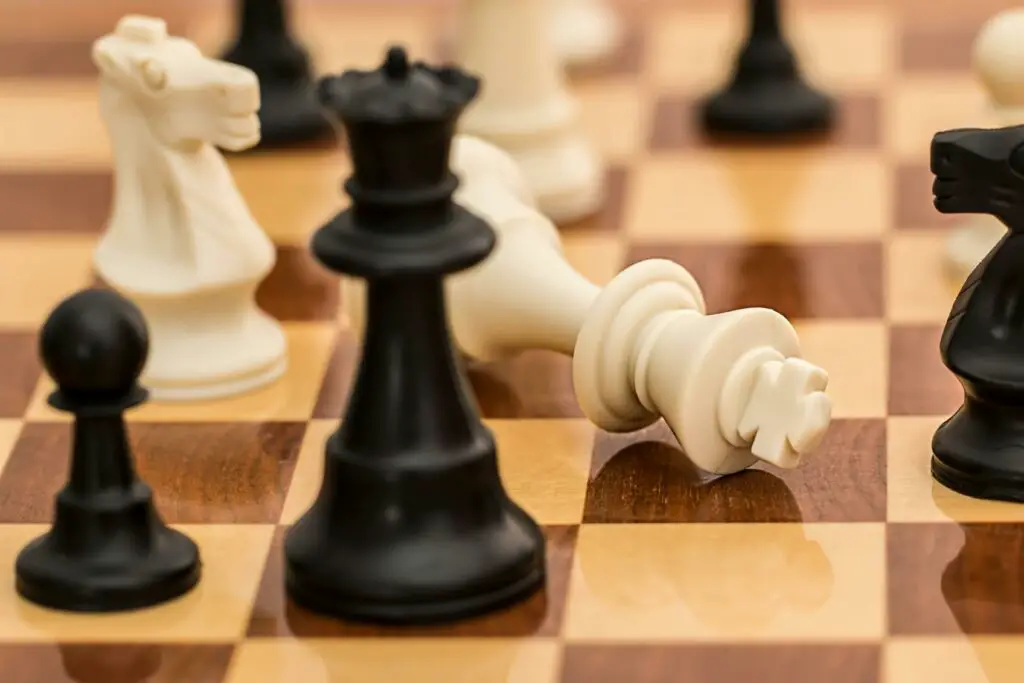How do you checkmate someone in chess?
Contents
Welcome to the exciting world of chess, where every move holds the promise of victory or defeat! If you’ve ever felt the rush of anticipation as you plot your next move, then you understand the allure of this timeless game. In this comprehensive guide, we’ll explore the intricacies of checkmate, the ultimate goal in chess, and unravel the strategies and techniques that will help you emerge triumphant on the battlefield.

Understanding Checkmate
At its core, checkmate represents the culmination of strategic prowess and tactical acumen, the moment when your opponent’s king is cornered with no escape route. It’s the crowning achievement of a well-executed plan, the climax of a battle waged across 64 squares. Understanding the significance of checkmate is paramount; it’s not just about capturing the king but about asserting dominance and seizing victory.
To appreciate the gravity of checkmate, consider a scenario where your opponent’s king is under relentless attack, hemmed in by your pieces on all sides. With each move, you tighten the noose, closing off avenues of escape and narrowing the king’s options. Finally, when the king finds itself in a position of utter vulnerability, you deliver the decisive blow: checkmate.
Basic Principles of Checkmating
To lay the groundwork for checkmate, you must adhere to fundamental principles that govern successful gameplay. Central to this is the concept of controlling the center of the board. By occupying key central squares with your pieces, you exert influence over the entire board and create pathways for attack.
Consider the following scenario: You deploy your knights and bishops to stake your claim in the center, anchoring your position and establishing a solid foundation for your offensive maneuvers. From this vantage point, you launch coordinated attacks, leveraging the strengths of your pieces to keep your opponent on the defensive.
1. Control the Center:
The center of the chessboard is like the heart of the battlefield, pulsating with strategic significance. Controlling central squares (d4, d5, e4, e5) allows you to exert influence over key areas of the board, enabling swift deployment of your pieces and facilitating coordinated attacks. By occupying the center early in the game, you establish a stronghold from which to launch your offensive and dictate the flow of play.
Example: In the opening phase of the game, focus on mobilizing your pawns and minor pieces toward the center. Deploy your knights to squares like c3/c6 and f3/f6, and aim to control the central d4 and e4 squares with your pawns. This central control sets the stage for future attacks and provides flexibility in maneuvering your forces.
2. Develop Your Pieces:
Pieces sitting idly on their starting squares are like soldiers awaiting orders—they must be mobilized to play an active role in the battle. The principle of development emphasizes the importance of bringing your pieces into the game, connecting them harmoniously, and positioning them for maximum effectiveness. Rapid development not only strengthens your position but also lays the groundwork for potential attacks and counterattacks.
Example: Instead of making aimless pawn moves in the opening, prioritize developing your knights and bishops to active squares. Knights often find ideal outposts on squares like f3/f6 and c3/c6, while bishops can exert influence along diagonals, targeting key squares in the center and on the flanks. Rapid development creates opportunities for piece coordination and enhances your overall board presence.
3. King Safety:
The safety of your king is paramount—a vulnerable king is like a general exposed on the front lines, susceptible to enemy attacks and vulnerable to checkmate threats. As the game progresses, take proactive measures to safeguard your king by castling early, fortifying its position with pawn cover, and maintaining a vigilant defense around its vicinity.
Example: Castling kingside or queenside provides a haven of safety for your king, tucking it away behind a wall of pawns and rooks. By castling, you not only relocate your king to a secure corner but also activate your rook, doubling its firepower along the respective file. Prioritize king safety as a strategic imperative, and your position will be fortified against potential threats.
4. Coordination and Cooperation:
Just as a well-oiled machine relies on seamless coordination among its parts, success in chess hinges on the harmonious interplay of your pieces. Coordinate your forces effectively, aligning them along common lines, ranks, and diagonals to maximize their collective strength and create synergistic threats. Cooperation among your pieces amplifies their impact and magnifies the pressure on your opponent.
Example: Imagine coordinating your rooks along the open file, creating a formidable battery that targets the enemy’s weak points and applies relentless pressure. By coordinating your pieces, you amplify their individual strengths and create a unified front that overwhelms your opponent’s defenses. Prioritize coordination and cooperation as the cornerstones of your strategic approach, and your checkmating opportunities will multiply.
By internalizing these basic principles of checkmating, you lay a solid foundation for success on the chessboard. Embrace these principles as guiding lights on your journey to mastery, and watch as your understanding deepens, your skills sharpen, and your victories multiply.
Key Checkmating Patterns
Checkmating patterns serve as the roadmap to victory, guiding your moves and shaping your strategies. Among the most prevalent patterns are the back-rank checkmate, queen and king checkmate, two rooks checkmate, and smothered checkmate.
Let’s take a closer look at the back-rank checkmate. In this scenario, your opponent’s king finds itself trapped behind its own pawns, unable to flee the advancing tide of your pieces. With a swift maneuver, you infiltrate the back rank with your rook, delivering the fatal blow and sealing your victory.
For instance, imagine a game where your opponent neglects their back rank, focusing solely on advancing their pieces. As the game progresses, you capitalize on this oversight, positioning your rook to exploit the vulnerability and secure a checkmate that leaves your opponent stunned.
In another example, the queen and king checkmate showcases the power and versatility of the queen. By orchestrating a coordinated assault with your queen and other pieces, you corral your opponent’s king into a corner, leaving it with nowhere to run.
Consider a game where you unleash a relentless onslaught, using your queen to control key squares and force the opponent’s king into a corner. With precise coordination and strategic finesse, you deliver the final blow, sealing your victory with a spectacular checkmate.
Practical Examples and Analysis
Studying practical examples and analyzing gameplay from historical and contemporary matches provides invaluable insights into the art of checkmating. Consider the immortal game between Adolf Anderssen and Lionel Kieseritzky, known as the “Evergreen Game.” In this legendary encounter, Anderssen sacrifices his queen to set the stage for a stunning checkmate, demonstrating the power of sacrifice and foresight in chess.
Another compelling example is the game between José Raúl Capablanca and Frank Marshall, famously known as the “Marshall Attack.” In this game, Capablanca navigates the complexities of the endgame to secure a decisive checkmate, showcasing his mastery of strategy and calculation.

Defensive Techniques Against Checkmate
While delivering checkmate is exhilarating, defending against it is equally crucial. Recognizing threats, fortifying your defenses, and anticipating your opponent’s moves are essential aspects of defensive play. By maintaining vigilance and shoring up your weaknesses, you can thwart even the most determined attacks.
Consider a scenario where your opponent launches a ferocious assault, aiming to deliver checkmate with a barrage of coordinated attacks. By staying calm under pressure and fortifying your defenses, you deny your opponent’s ambitions and turn the tide in your favor.
Endgame Checkmating Strategies
In the endgame, when the board is sparse and the stakes are high, mastering checkmating strategies becomes paramount. King and pawn endgames, minor piece endgames, and other endgame scenarios require precise calculation and strategic finesse to secure victory.
Imagine a scenario where you navigate the complexities of the endgame, leveraging your remaining pieces to orchestrate a decisive checkmate. With careful planning and precise execution, you navigate the endgame maze and emerge victorious, leaving your opponent in awe of your mastery.
Tips for Improving Checkmating Skills
Improvement in chess comes with practice, patience, and perseverance. Engaging in checkmate-themed puzzles, studying master games, and honing your tactical awareness will sharpen your skills and elevate your game to new heights. Remember, mastery is a journey, not a destination, and every game is an opportunity to learn and grow.

Conclusion
In conclusion, mastering the art of checkmate is a journey filled with challenges and triumphs, but the rewards are well worth the effort. By understanding the principles, patterns, and strategies outlined in this guide, you’ll be better equipped to navigate the complexities of the chessboard and emerge victorious against even the most formidable opponents. So, embrace the thrill of the game, hone your skills, and may your checkmates be swift and decisive!





